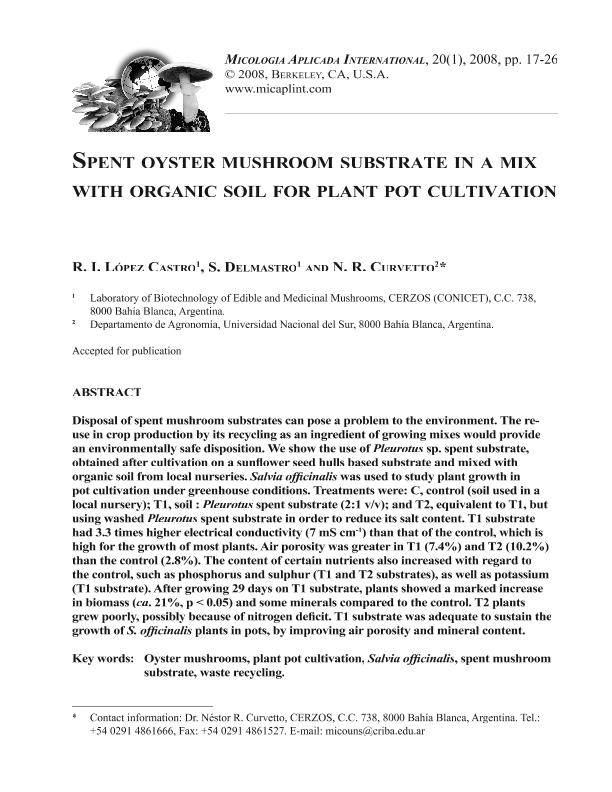Mostrar el registro sencillo del ítem
dc.contributor.author
López Castro, Ramón Ignacio

dc.contributor.author
Delmastro, Silvia Elena

dc.contributor.author
Curvetto, Nestor Raul

dc.date.available
2017-12-13T17:11:13Z
dc.date.issued
2008-12
dc.identifier.citation
López Castro, Ramón Ignacio; Delmastro, Silvia Elena; Curvetto, Nestor Raul; Spent Oyster Mushroom Substrate in a Mix with Organic Soil for Plant Pot Cultivation; Institut de Recherche pour le Développement; Micología Aplicada International; 20; 1; 12-2008; 17-26
dc.identifier.issn
1534-2581
dc.identifier.uri
http://hdl.handle.net/11336/30459
dc.description.abstract
Disposal of spent mushroom substrates can pose a problem to the environment. The reuse in crop production by its recycling as an ingredient of growing mixes would provide an environmentally safe disposition. We show the use of Pleurotus Pleurotus sp. spent substrate, sp. spent substrate, obtained after cultivation on a sunfl ower seed hulls based substrate and mixed with organic soil from local nurseries. Salvia offi cinalis Salvia offi cinalis was used to study plant growth in was used to study plant growth in pot cultivation under greenhouse conditions. Treatments were: C, control (soil used in a local nursery); T1, soil : Pleurotus Pleurotus spent substrate (2:1 v/v); and T2, equivalent to T1, but spent substrate (2:1 v/v); and T2, equivalent to T1, but using washed Pleurotus Pleurotus spent substrate in order to reduce its salt content. T1 substrate spent substrate in order to reduce its salt content. T1 substrate had 3.3 times higher electrical conductivity (7 mS cm-1) than that of the control, which is high for the growth of most plants. Air porosity was greater in T1 (7.4%) and T2 (10.2%) than the control (2.8%). The content of certain nutrients also increased with regard to the control, such as phosphorus and sulphur (T1 and T2 substrates), as well as potassium (T1 substrate). After growing 29 days on T1 substrate, plants showed a marked increase in biomass (ca. 21%, p < 0.05) and some minerals compared to the control. T2 plants grew poorly, possibly because of nitrogen defi cit. T1 substrate was adequate to sustain the growth of S. offi cinalis S. offi cinalis plants in pots, by improving air porosity and mineral content.
dc.format
application/pdf
dc.language.iso
eng
dc.publisher
Institut de Recherche pour le Développement
dc.rights
info:eu-repo/semantics/openAccess
dc.rights.uri
https://creativecommons.org/licenses/by-nc-sa/2.5/ar/
dc.subject
Oyster Mushrooms
dc.subject
Plant Pot Cultivation
dc.subject
Salvia Officinalis
dc.subject
Spent Mushroom Substrate
dc.subject
Waste Recycling
dc.title
Spent Oyster Mushroom Substrate in a Mix with Organic Soil for Plant Pot Cultivation
dc.type
info:eu-repo/semantics/article
dc.type
info:ar-repo/semantics/artículo
dc.type
info:eu-repo/semantics/publishedVersion
dc.date.updated
2017-10-20T19:50:35Z
dc.journal.volume
20
dc.journal.number
1
dc.journal.pagination
17-26
dc.journal.pais
México

dc.journal.ciudad
Puebla
dc.description.fil
Fil: López Castro, Ramón Ignacio. Consejo Nacional de Investigaciones Científicas y Técnicas. Centro Científico Tecnológico Conicet - Bahía Blanca. Centro de Recursos Naturales Renovables de la Zona Semiárida. Universidad Nacional del Sur. Centro de Recursos Naturales Renovables de la Zona Semiárida; Argentina
dc.description.fil
Fil: Delmastro, Silvia Elena. Consejo Nacional de Investigaciones Científicas y Técnicas. Centro Científico Tecnológico Conicet - Bahía Blanca. Centro de Recursos Naturales Renovables de la Zona Semiárida. Universidad Nacional del Sur. Centro de Recursos Naturales Renovables de la Zona Semiárida; Argentina
dc.description.fil
Fil: Curvetto, Nestor Raul. Consejo Nacional de Investigaciones Científicas y Técnicas. Centro Científico Tecnológico Conicet - Bahía Blanca. Centro de Recursos Naturales Renovables de la Zona Semiárida. Universidad Nacional del Sur. Centro de Recursos Naturales Renovables de la Zona Semiárida; Argentina. Universidad Nacional del Sur. Departamento de Agronomía; Argentina
dc.journal.title
Micología Aplicada International
dc.relation.alternativeid
info:eu-repo/semantics/altIdentifier/url/http://www.micaplint.com/pdf/V20_1_02.pdf
Archivos asociados
